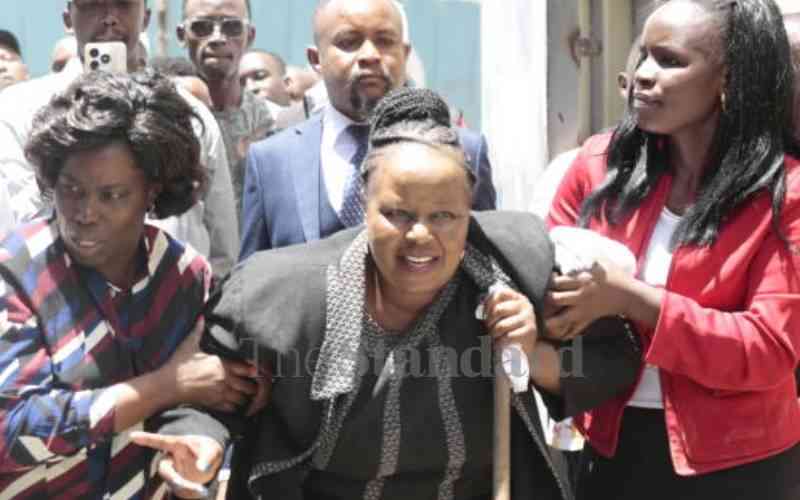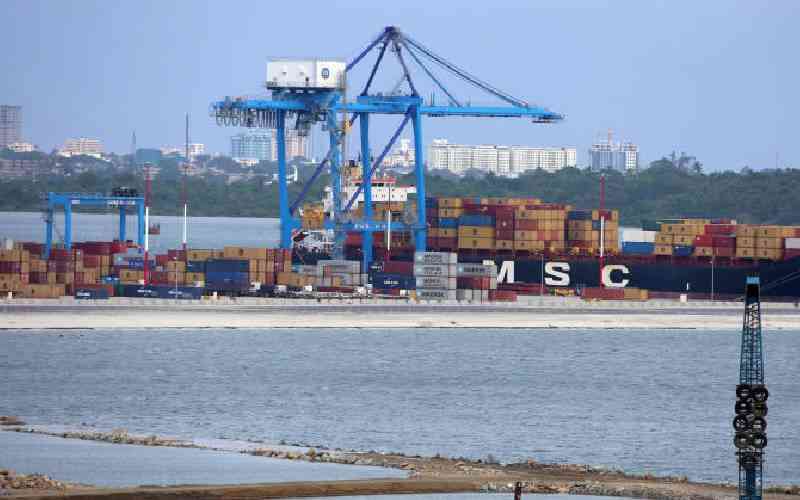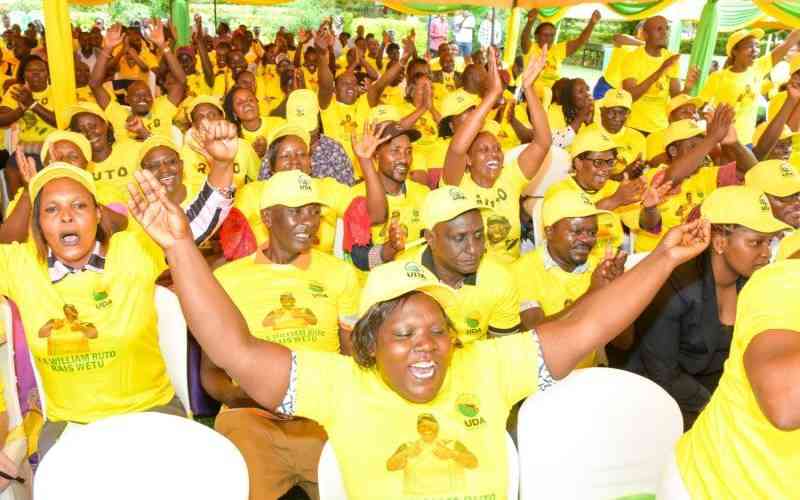By Dann Okoth
Fresh controversy stalks a multi-billion-shillings railway expansion project after key players disagreed over implementation plans. The World Bank, the key financier of the project, has accused Kenya Railways Corporation (KRC) of dragging its feet in adopting agreed project plans.
World Bank communications officer Peter Warutere says KRC has so far not been keen to speed things up and has often acted against agreement reached in consultations with stakeholders. "We were surprised, for instance, when KRC issued an eviction notice for the squatters when we were working on modalities on how to relocate them," he said. |
Protesters destroy railway line passing through Kibera slums. Photo: File/Standard
|
A jolt in the project to relocate tens of thousands of squatters from the railway reserve and pave way for rail expansion could also affect the ambitious proposed Sh320 billion modern railway network from the port of Mombasa to Malaba. The plans almost fell in disarray after the corporation issued a quit notice to squatters living on its land, particularly the railway reserve, failure to which they would be forcefully evicted and prosecuted.
Eviction threats
In a newspaper advertisement on March 21, the corporation declared that it would, within a month, repossess all land within 100 feet on either side of the railway line, which is reserved for railway operations to ensure safety of railway traffic as well as the general public. Some 50,000 people living in Kibera and Mukuru slums would have been affected, a development that elicited angry reactions from the slum dwellers and civil society groups.
The residents and the human rights activists argued that the corporation was acting in disregard of international laws on eviction. The human rights groups, including Hakijamii, Shelter Forum and Amnesty International appealed to President Kibaki to stop the intended evictions, saying many had built their livelihoods along that railway line and could lose property, shelter and incomes.
But KRC Managing Director Nduva Muli denied that the corporation was dragging its feet, adding that they did not intend to evict people in Kibera and Mukuru slums. "The slums are a special case because they are included in the East African Trade and Transport Facilitation Project (EATTFP) funded by the World Bank, which seeks to find alternative settlement for them," says Muli.
Compensation claims
He says the notice applied to squatters encroaching on railway land in other parts of the country. But the corporation’s efforts to evict people elsewhere in Mombasa and Kisumu have been met with similar opposition with would-be evictees demanding compensation and resettlement. Last week the Ministry of Transport, which is a key player in the EATTFP programme implementation, threw the ball back to KRC court, claiming the buck stops with the corporation.
"As a ministry we are just overseers of such projects. The implementation squarely lies with KRC," said a Mr Hunda of the Ministry of Transport who oversees such projects. But the negative undercurrents do not augur well for the country as they could delay the implementation of Government’s plans to build a high speed rail system that would cut transport costs and subsequently, cost of goods.
Finance Minister Uhuru Kenyatta set aside funds in the 2009-2010 budget to initiate the development of the railway line whose construction is projected to start in May next year and end in 2016. It is expected to connect the port of Mombasa and Malaba, with a branch line to Kisumu.
The rail would carry double-decker passenger trains, cruising at speeds of 160kph and goods trains cruising at 120kph. However, the catch is that such trains may pass in Kibera because the new one would run next to the 100-year old rail line currently being operated by Rift Valley Railways (RVR).
Despite the requirements to have a railway reserve free for railway operations and safety, parts of the railway reserve have been encroached. Large numbers of people have encroached the railway reserve in both Kibera and Mukuru, residing and carrying out business there.
At several places markets have been established on both sides of the railway line. The railway line is used as a path not only for accessing the market stalls, but also for pedestrian traffic moving to and from the city centre and industrial area.
Stay informed. Subscribe to our newsletter
Compromising safety
The result of this encroachment is that trains can only move through the area at low speeds, causing inordinate delays. In addition the excessive human traffic and businesses operated in the area results in waste and rubbish being dumped on the tracks. This dumping impedes drainage and compromises the performance of the track structure. In the event of accidents or derailments, many people and structures would be exposed to unacceptable risk and danger.
In addition, since the concessionaire expects to improve freight services, it is essential that operational speeds throughout the railway system be increased. The above factors, therefore, require that a clear corridor of operation is established in Kibera and Mukuru to improve railway safety and operation.
It is, therefore, proposed to implement the relocation of people residing, undertaking business or otherwise occupying the reserve, who are the Project Affected Persons (PAPs), within the entire 60-metre railway operation corridor. But although the World Bank has proposed some Sh600 million as contained in the EATTFP revised procurement plan (2008-2010) in the initial funding to draw up logistical plans and put up provisional structures ahead of the relocation, stakeholders say the project could be long drawn.
"It is a complex project because it will not only require us to build decanting sites to temporarily settle the squatters, but other structures like markets and footpaths would have to be constructed since the slum dwellers also use the railway line as a market and a path," says Muli. Indeed, the actual cost of the project, what is referred in the AETTFP as MOT/KRC component is not yet known.
"We will only know the actual cost after Pamoja Trust provides the final report," said Warutere.Pamoja Trust is the organisation contracted by the World Bank to carry the Relocation Action Plan (RAP) evaluation process. But already it is encountering teething problems on the ground that might hinder a speedy implementation of the project.
Emerging issues
The organisation reports that while there is a general acceptance of the RAP process among the wider Project Affected People, there are emerging issues that may in future affect the implementation of the project. According to the draft final report for the revision of RAP presented to the World Bank by Pamoja Trust, the issues of contention appear to be a jostling for recognition as to who should be the legitimate PAP representative organisation.
"This contestation is between the traditional slum village leadership in parts of Soweto East and Laini Saba segments in Kibera and Ngazi ya Chini," says the report. "There is a similar contestation in the whole of Mukuru area between Ngazi ya Chini and the member schemes of the National Federation of Slum Dwellers, Muungano wa Wanavijiji," it adds. This conflict, notes the report, is in part a reflection of the varying social, economic, cultural and political dynamics that exist, not only from settlement to settlement but also from zone to zone within a settlement.
However, such emerging issues might be the project’s Achilles heels as implementers race to beat completion deadline. But human rights groups maintain fairness and rule of law must be observed while carrying out the re-location. "Kenya is a signatory to the Universal Declaration of Human Rights and particularly to the International Covenant on Economic, Social and Cultural Rights Article 11, which protects the rights of the evictees and the Government must ensure this," says Mr Odindo Opiata, Director, Economic and Social Rights Centre.
 The Standard Group Plc is a
multi-media organization with investments in media platforms spanning newspaper
print operations, television, radio broadcasting, digital and online services. The
Standard Group is recognized as a leading multi-media house in Kenya with a key
influence in matters of national and international interest.
The Standard Group Plc is a
multi-media organization with investments in media platforms spanning newspaper
print operations, television, radio broadcasting, digital and online services. The
Standard Group is recognized as a leading multi-media house in Kenya with a key
influence in matters of national and international interest.
 The Standard Group Plc is a
multi-media organization with investments in media platforms spanning newspaper
print operations, television, radio broadcasting, digital and online services. The
Standard Group is recognized as a leading multi-media house in Kenya with a key
influence in matters of national and international interest.
The Standard Group Plc is a
multi-media organization with investments in media platforms spanning newspaper
print operations, television, radio broadcasting, digital and online services. The
Standard Group is recognized as a leading multi-media house in Kenya with a key
influence in matters of national and international interest.









